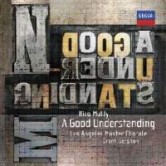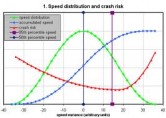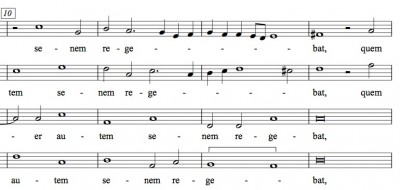Distractions and the Tyranny of Influence
from Sunday, September12th of the year2010.
I went to Los Angeles last week! Grant Gershon and the LA Master Chorale and I played a little show-and-tell type thing at the Apple Store in Santa Monica. It was, surprisingly a lot of fun — I am always nervous about overly formalized performances in non-performance spaces (one idea I had a few months ago would be to just have roaming bands of singers chanting something, but that would require new writing just for a weird in-store, and as much as I think “Choral Flash Mob” is the wave of the future, I didn’t have it in me to organize it from Afar). I love Apple Store employees; I have made it a tradition since I’m 18 to only buy computers from women, because at Apple this is universally possible and usually really fun. The kids in the store in Santa Monica were great: well-listened, excitedly groomed, unfailingly polite + profesh.
 All of this was in service of promoting the release of a new album of my choral music, available from all fine retailers either now or soon, depending on where you’re reading this. Here is some specific information from the Decca Mini-Site; I’m thrilled to be able to release this, although, honestly, it really belongs to Grant Gershon and the Los Angeles Master Chorale, who have invested an enormous amount of time and money in the project. It’s a great honor to have an ensemble dedicate so many of their resources not to me but to my music; it makes me feel like I’ve done a good job putting the notes on paper if they can be played and recorded without my being there, obsessively worrying about each little click and bleep. There is also another album! Two at once!
All of this was in service of promoting the release of a new album of my choral music, available from all fine retailers either now or soon, depending on where you’re reading this. Here is some specific information from the Decca Mini-Site; I’m thrilled to be able to release this, although, honestly, it really belongs to Grant Gershon and the Los Angeles Master Chorale, who have invested an enormous amount of time and money in the project. It’s a great honor to have an ensemble dedicate so many of their resources not to me but to my music; it makes me feel like I’ve done a good job putting the notes on paper if they can be played and recorded without my being there, obsessively worrying about each little click and bleep. There is also another album! Two at once!
The second is a ballet score for Stephen Petronio’s I Drink the Air Before Me, made in collaboration with Bedroom Community.  If you buy it from Bedcom’z Bandcamp Site I think you get two bonus tracks (A Long Line and Twitchy Organs), so: everybody go crazy! We are going to be performing it live in London on the 5th and 6th of October, so do come if you’re in town. This is a week and one day after the Whale-Watching Tour comes to the Barbican, so, come to that too, if you can bear it! I’ll be holding court at the bar at St John, most likely, so pop by and holla.
If you buy it from Bedcom’z Bandcamp Site I think you get two bonus tracks (A Long Line and Twitchy Organs), so: everybody go crazy! We are going to be performing it live in London on the 5th and 6th of October, so do come if you’re in town. This is a week and one day after the Whale-Watching Tour comes to the Barbican, so, come to that too, if you can bear it! I’ll be holding court at the bar at St John, most likely, so pop by and holla.
I want to dive a little deeper into one of the pieces on the Choral album just for a moment. The first week I joined a boys’ choir in Providence, it was, if memory serves, an off-week that didn’t actually involve a choral service, so the choirmaster took the time to look forward in the season to Advent and Christmas motets. The very first thing we looked at was this Byrd anthem:
[audio:BillyBSenex.mp3]
William Byrd Senex Puerum Portabat
King’s College Cambridge / Cleobury
Now. It is gorgeous. The choirmaster made us a loose translation of the words, (The old man carried the child, but the child ruled the man; the child, who was born of a virgin (who remained a virgin after that time): she also adored him). It’s a beautiful little text. I was freaking out about one little detail, though. Check this out — also, sorry about the lack of clefs or signatures, we’re in one flat, squeezing this into the right width is just not going to happen at this juncture:
See in bar 12, the trebles have this long melisma on the syllable “ge,” and they have to double up on the f? You have to do a little arabic glottal stop, and it’s just a tiny blink, but it focuses the phrase. Also, the deliciousness of f-natural to f-sharp right after that, with all those major and minor modes reflecting around the church: it was a very strange emotional moment for me: I wasn’t really sure what about it I was reacting to, but I was having a very serious reaction. Part of it was that while we were encouraged to ask questions about the text with the goal of understanding it, the implication was that the notes would make their own sauce without too many hysterical interpretive gestures. Even after a few years inside the liturgy, the wonderful subtleties of the texts continue to unfold, I assume, until death and beyond. The strangeness of the situation (a bunch of American 10 year olds singing a narrative about a Jewish mother 2000 years ago) and the ecclesiastical hush of the interpretation all gave me a serious shiver.
Fast forward twenty years, when I was asked to write a Christmas motet for the wonderful Vox ensemble with seasonally appropriate brass. I knew I wanted to set the Byrd text, but I also needed to write something slightly longer, that would justify having trombones, so I appended the wonderful Hodie Christus natus est text:
Hodie Christus natus est:
Hodie Salvator apparuit:
Hodie in terra canunt Angeli,
Laetantur Archangeli
Hodie exsultant justi, dicentes:
Gloria in excelsis Deo.
Alleluia.
Everybody and their mom has set this text — there is a wonderful Gabrielli, there are two or three Palestrina settings, there’s a Sweelinck one that slays me. So I thought it would be safe to try. (Also, FYI, I downloaded this text from the CPDL.org, an amazing site devoted to free downloads of choral scores, but their Latin had, like, two typos in it, so be careful what you download from the internet!)
[audio:NicoSenex.mp3]
Nico Muhly Senex Puerum Portabat
from A Good Understanding
Grant Gershon & the Los Angeles Master Chorale
The way I structured it was around a single drone (a G) over which we could imagine an old man gingerly carrying a child. I love a drone in the middle of a texture: rather than a pedal point or an inverted pedal, a center drone focuses the ear like nutmeg in a sauce. The brass join, and the drone repeats, this time with slightly more Regal pomp. The G stays with us this whole time, tossed around between the trumpets and the singers. A big crescendo, and suddenly we are at Christmas day, with the Hodies, dragging us out of the g, and delivering the first chord with no G – an aleatoric, ecstatic repeating pattern on “Gloria in excelsis Deo” – the initial drones made electric, anxious, and all-encompassing. A series of overlapping and messy brass triads wipe the sky clean, and we’re left with another drone on two notes (a and b) and the text “Alleluia,” sung quietly.
[Side note: Somebody help me! What is the typesetting protocol for a letter used as a note name? I’ve been bolding, but I think that might be if the letter is meant to indicate a shape rather than a pitch — like, you should say, …the house is an X-shaped affair, situated at the end of a park…. — but sometimes in serif situations I’ve seen “letter as shape” rendered in sans-serif? Or should I just choose do ré mi fa sol? @kariemil @jennyd @mattbrown help me get to the bottom of this!!!]
 The musical language of Senex is, I hope, appropriate for church but also appropriate for private listening. The language comes from a lot of very specific places: the simplicity of Byrd’s lines, a Glassian commitment to drones (the first movement of Music in 12 Parts, in which an open fifth secretly sounds in every beat of the piece, has long been the best example of emotion being wrung from formality I can think of), and some very obvious things at the end: Stravinsky always haunts me about spacings, especially for brass; the Symphonies of Wind Instruments and the Sympherny of Psalms and really all them Symphonies are lurking in these textures. The polytonal brass swells are janked pretty explicitly from the ending of Harmonielehre by John Adams, and you can hear some Reich in the trumpet and voice canons towards the beginning. I love listening to this piece because I can hear my influences but I can also hear them melting into each other and correlating in a way that has little to do with their original contexts. This is, for me, a good thing. Influence is uncontrollable, like genetics, but I like to think that what you do with it is what defines style.
The musical language of Senex is, I hope, appropriate for church but also appropriate for private listening. The language comes from a lot of very specific places: the simplicity of Byrd’s lines, a Glassian commitment to drones (the first movement of Music in 12 Parts, in which an open fifth secretly sounds in every beat of the piece, has long been the best example of emotion being wrung from formality I can think of), and some very obvious things at the end: Stravinsky always haunts me about spacings, especially for brass; the Symphonies of Wind Instruments and the Sympherny of Psalms and really all them Symphonies are lurking in these textures. The polytonal brass swells are janked pretty explicitly from the ending of Harmonielehre by John Adams, and you can hear some Reich in the trumpet and voice canons towards the beginning. I love listening to this piece because I can hear my influences but I can also hear them melting into each other and correlating in a way that has little to do with their original contexts. This is, for me, a good thing. Influence is uncontrollable, like genetics, but I like to think that what you do with it is what defines style.
So it is with some anxiety that I read Kyle Gann’s blogpost the other day, entitled “A Couple of Complaints.” It’s worth a read, as everything Kyle writes is. But then check this out:
Secondly: I think young composers might want to think about diversifying the composers they base their styles on beyond John Coolidge Adams. Not that there’s anything wrong with Adams’s style, he’s as good a place to start as any. But I get CDs from composers in their 20s and 30s, all very talented, very accomplished – most of them sounding like they’re trying to be the next John Adams. Then I get asked for recommendations, and I can’t make distinctions among them, because one’s as good an Adams epigone as the next.
And this attitude, of course, begetz this in the comments thread: “Good thoughts as well on broadening influences. I wonder if a lot of younger composers see JC Adams’ style as a fast track to success.” Guh. These people have the whole thing backwards. Style is not a hat that you just buy. Style is a weird, growing, plant-like thing that reacts against and works with a bunch of different input sources: experience, age, what you listen to, what you don’t listen to, what you read, what your roommates read, what you heard one time in a car when you were 13, what you listen to now in a car that you’re 29. If anybody wakes up and is like, “I should like to be successful! How shall I do that? Ah! By writing music by John Adams, who is, himself, Successful.” I really don’t think anybody wakes up and thinks that, and if they do, surely their music would sound as flawed as their logic. Think about it like food: David Chang is a successful restaurateur, in all senses of the word – although from what one reads, he sounds a little depressed and hyper, which is something I understand all too well, where commercial stroke press stroke general on-dit success doesn’t necessarily osmose into the interior life. Yes, you could wake up and want to build a restaurant like his. But if you can’t cook, it’s just not going to work, because style is a process, and not a jacket that you just throw on and suddenly people are making it rain. Instead, surely what you do is get a job in his kitchen, and learn technique. It’s the same thing with Stravinsky: what makes him amazing is, for me, his spacings, the way he gets air into the chords and controls textures. With Adams, I love a west coast visual sensibility combined with an east-coast neurosis and internal metronome. Reich writes fast music inside slow music, which is kind of like those French desserts which are simultaneously hot and cold. Just keep telling yourselves that style is a process and a technique, and don’t let other generations lure you into the trap of style itself being a commodity.  It ties in too quickly to boilerplate jealousy and issues of composers being “overrated” and “underrated” as if there’s some kind of Style Death Panel in the sky somewhere assigning Schönberg a rating of 60, Berg an 82, Gann a 45, Gubaidulina a 54.5 — it’s just not how it works and we have to stop wasting our time on this shit. The idea that a musical history text and how many column inches a certain composer should get, gets now, might get later… it’s really beside the point. Trying to contextualize a process is well and good, but I think the nature of an organic process is that you never quite know where it’s going to end up.
It ties in too quickly to boilerplate jealousy and issues of composers being “overrated” and “underrated” as if there’s some kind of Style Death Panel in the sky somewhere assigning Schönberg a rating of 60, Berg an 82, Gann a 45, Gubaidulina a 54.5 — it’s just not how it works and we have to stop wasting our time on this shit. The idea that a musical history text and how many column inches a certain composer should get, gets now, might get later… it’s really beside the point. Trying to contextualize a process is well and good, but I think the nature of an organic process is that you never quite know where it’s going to end up.
 I should add here that it is a disorder of composers that no matter how successful (which is a curse word) one is accused of being by other composers, we will perpetually insist that that scale of reference is twisted and that, in fact, there are countless other composers who enjoy the right kind of success that one oneself wants/deserves — it’s an endless cycle that we should try to dismantle as soon as possible. Haven’t we all slapped our faces in embarrassment reading history textbooks about how Tchaikovsky hated Brahms or Brahms hated Bach or Mozart hated whomever or Lizst gave somebody the clap and wouldn’t give somebody else no pussy and then Virgil Thomson said something nasty about Terry Riley and it’s like children.
I should add here that it is a disorder of composers that no matter how successful (which is a curse word) one is accused of being by other composers, we will perpetually insist that that scale of reference is twisted and that, in fact, there are countless other composers who enjoy the right kind of success that one oneself wants/deserves — it’s an endless cycle that we should try to dismantle as soon as possible. Haven’t we all slapped our faces in embarrassment reading history textbooks about how Tchaikovsky hated Brahms or Brahms hated Bach or Mozart hated whomever or Lizst gave somebody the clap and wouldn’t give somebody else no pussy and then Virgil Thomson said something nasty about Terry Riley and it’s like children.
(An aside: none of this is meant to be ragging on Kyle, who I think might feel rather beleaguered when people get all up in his business. His blog is one of the few that opens every time I open my browser, and he is one of the most delicious analytical voices on- and offline. Check out how good he is when talking about the music he loves here.)


11 Comments
September 12th, 2010 at 9:53 pm
This post gave me a serious shiver. I don’t know anyone who talks about music quite the way you do – from the inside, to be sure, but with a sensitivity to what will most help the listener sense the way a piece moves from start to finish.
This whole disc is glorious; even the familiar Bright Mass sounded new and the canons crystalline. Sometime I hope you will talk about your sense of endings.
September 13th, 2010 at 12:28 pm
Thanks for the generous link to Kyle Gann’s writing. The blog you selected–visual, informed, provocative–is a master class in miniature.
September 13th, 2010 at 2:08 pm
I’m seriously considering committing suicide. I just CAN’T download A good understanding for I’m stuck in that moody country that is France where the album is still not released ; and neither amazon.co.uk or iTunes UK will work. I atrocely miss the good old time when I could come and see you playing in London or listen to Thomas Gould performing Seeing is believing in Nottingham – whereas here in France nobody would play composers who are not dead yet. Can’t wait till I come back and finally settle in a civilised country – lovely Britain.
On that bitter moment I just wanted to say that your music is profoundly interesting and moving. I could never have enough of it. Roundhouse, Camden, in Spring was amazing. I can only wish you all the best with your work, please carry on filling our minds with wonder.
Pierre
September 13th, 2010 at 7:56 pm
Congrats on the CDs, Nico! I look forward to getting “A Good Understanding” on the less-compressed format when it becomes available. I was one of the tenors, and we had a lot of fun in the recording sessions. I was especially fond of the “Senex” (a word which, during its repetition, started to sound like “Xanax” in some of the outtakes) and the title track.
Although I’m probably not the same “Matt Brown” you referred to in the post (there are probably about 300 of us in L.A. alone!), here’s my $.02 about the typesetting of note names:
I would just use capital letters–no bold needed. You might say G4 for added specificity. Solfegge is also acceptable, but using German note names would be a little silly (unless one is spelling out B-A-C-H).
Keep up the blog!
September 14th, 2010 at 11:14 am
What a brilliant use of the Rembrandt Joseph!
Your blog is always full of great illustrations with both bold and subtle connections to the writing. I can taste the undertone of nutmeg.
x
September 16th, 2010 at 7:53 pm
Speaking of Chang, this here has been read: http://www.newyorker.com/reporting/2008/03/24/080324fa_fact_macfarquhar?currentPage=all.
September 25th, 2010 at 5:48 am
My favorite, elegantly precise feature of your blog are the audio clips, like this Byrd piece offered alongside your own. Please repost the Britten arrangement of The Holly and the Ivy this Christmas. I listened to that for hours when you posted it before. Sublime. Also: both your new records are wonderful. Thank you for brightening my recovery from a rather untidy bout with cancer.
September 26th, 2010 at 2:12 pm
Infectious obsessions! Lovely albums.
“Professor Bruno Latour,from the Centre de Sociologie de Paris argues that religion is not about a domain of reality, some specific entities, a certain type of morality, or a belief system-but literally a way of talking, a Verb, as the tradition says, or in a more technical vocabulary: a specific regime of enunciation. ”
http://www.uctv.tv/search-details.aspx?showID=6925
October 2nd, 2010 at 6:50 am
Your analogy of the drone focusing the ear like nutmeg in a sauce will stay with me forever.
October 3rd, 2010 at 12:37 pm
Definitely a very Noye’s Fludde feel to I Drink The Air.
October 5th, 2010 at 9:06 pm
Congratulations on the recordings. They are lovely. Will have an enjoyable time absorbing both. I hope that the live performance of “I Drink . . .” went well this week.